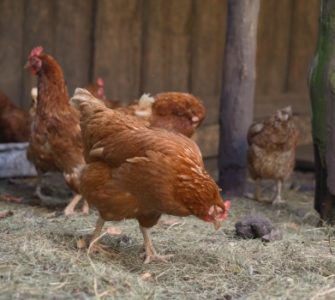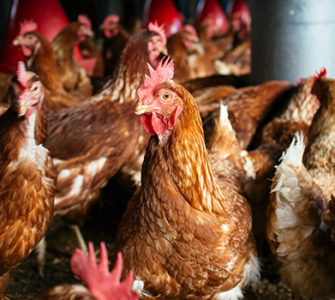Management, vaccination keys to Salmonella prevention in cage-free egg layers
By John Brown, DVM
Senior technical services veterinarian, Zoetis
The number of cage-free egg layers has soared in recent years, raising questions about the impact the production system might have on the prevalence of foodborne Salmonella.
Between 2017 and 2022, cage-free layer production increased nearly 200%. By January 2022, there were 111 million cage-free layers.1 The predominant foodborne pathogen in layers that’s of concern is Salmonella Enteritidis; Salmonella Typhimurium can also occur, though to a lesser extent.2
Studies comparing the prevalence of Salmonella among different types of production systems for layers have yielded different results.3 Personally, I haven’t seen much difference in Salmonella prevalence between caged and cage-free hens. The risk for Salmonella seems to be less related to the type of system and highly related to management, and the best control of Salmonella I’ve witnessed is achieved when good management is coupled with vaccination.
Potential for horizontal transmission
It’s probably true that among hens in cage-free systems there is more potential for horizontal transmission of Salmonella simply because birds have more access to each other.
Although there are pens within cage-free systems that separate different groups of birds, the birds within each section have access to each other’s manure and to dust created by birds. Feces and dust are reservoirs for Salmonella. Cage-free production also raises the risk of birds coming into contact with rodents, which are Salmonella vectors.
On the other hand, layers tend to stay in their own little section of a building, and they use one particular nest all the time that may reduce horizontal exposure. They choose their preferred area when they start laying eggs.
Asking for trouble
Issues with Salmonella are certain to rise when sanitation, rodent control and biosecurity are lacking. When any of these important management chores are neglected, Salmonella will be a problem in any type of production system.
It’s important to remember that simple, everyday biosecurity measures, such as changing shoes between buildings, helps prevent people tracking in Salmonella as well as a host of other pathogens into poultry houses.
Not surprisingly, stocking density can also affect the prevalence of Salmonella; a lower density is associated with less fecal shedding of Salmonella.4,5
Vaccination plays key role
The industry has done a phenomenal job regarding vaccination of layer flocks against Salmonella. When S. Enteritidis first came to prominence in the layer industry, it was more often transmitted vertically from breeders to offspring. Once breeder producers upped testing, eliminated positive flocks and implemented Salmonella-vaccination programs, vertical transmission was brought under control.
I would estimate that today, 100% of shell-egg producers and around 90% of the breaker-egg segment of the layer industry now vaccinate against Salmonella.
Vaccination programs are obviously going to differ, but most involve use of live and inactivated Salmonella vaccines because each kind has its own attributes.
One example of a Salmonella-vaccine protocol for layers would start with administration of a live S. Typhimurium vaccine given at 1 day of age and another at 2 to 3 weeks of age; some producers give a third dose at 6 to 10 weeks of age. Live Salmonella vaccines are thought to elicit a broad host-immune response.6
Protection from live vaccines, however, may not last as long as laying hens are in production, so an inactivated vaccine is also often given around 12 to 14 weeks of age. Inactivated vaccines generally require injection. They can help protect against multiple strains of Salmonella,7 although some of the live Salmonella vaccines have also been shown to provide cross-protection.8
It takes time for vaccine-initiated immunity to develop so hens need to be protected from Salmonella in the meantime — which, here again, underscores the importance of good sanitation and biosecurity.
Ensuring vaccine coverage
It’s my opinion that all the commercially available Salmonella vaccines for poultry are good-quality vaccines. They do what they’re supposed to.
Nevertheless, for Salmonella vaccination to be successful, care must be taken to ensure that 100% of the birds get the vaccines administered. Directions for proper administration of vaccines must be followed carefully, and vaccination crews injecting Salmonella vaccines should be monitored.
Uniform vaccine administration can be further confirmed by serology 4 weeks after the inactivated vaccine is given. Almost all producers vaccinate for Salmonella in combination with vaccination for other diseases. We’ve found that an enzyme-linked immunoassay (ELISA) for Newcastle disease is a more reliable indicator of vaccine accuracy than testing for Salmonella. If Newcastle disease antibody titers are good upon ELISA testing, it indicates that vaccine administration was well done.
Editor’s note: The opinions and advice presented in this article belong to the author and, as such, are presented here as points of view, not specific recommendations by Poultry Health Today.
All trademarks are the property of Zoetis Services LLC or a related company or a licensor unless otherwise noted.
1 UB Consulting: Analyzing the Growth of the Cage-Free Egg Market. 2022 Feb 25. https://www.urnerbarry.com/News/1219575/UB-Consulting-Analyzing-the-Growth-of-the-Cage-Free-Egg-Market Accessed May 13, 2022.
2 Ibid.
3 Gast R, et al. Frequency and Duration of Fecal Shedding of Salmonella Enteritidis by Experimentally Infected Laying Hens Housed in Enriched Colony Cages at Different Stocking Densities. Front Vet Sci. 2017 Apr 10;4:47.
4 Ibid.
5 Gast RK, et al. Frequency and Duration of Fecal Shedding of Salmonella Serovars Heidelberg and Typhimurium by Experimentally Infected Laying Hens Housed in Enriched Colony Cages at Different Stocking Densities. Avian Dis. 2017;61(3):366-371.
6 Jia S, et al. Challenges in vaccinating layer hens against Salmonella typhimurium. Vaccines. 2020 Nov 19;8(4):696.
7 Ibid.
8 Muniz E, et al. Evaluation of the effectiveness and safety of a genetically modified live vaccine in broilers challenged with Salmonella Heidelberg. Avian Pathol. 2017;46(6):676-682.
©2022 Zoetis Services LLC. All rights reserved. BIO-00359
Posted on December 22, 2022

















